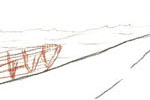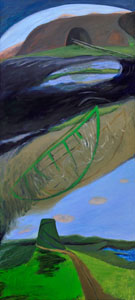Travelling backwards
Hans Landsaat was travelling by train one day in an almost empty compartment, when a friendly but astonished conductor came up to him and mentioned that he could choose another seat. The man could not grasp why Hans was sitting there where he would only see the landscape receding into the distance. Hans was "travelling backwards" and this has been the title of numerous paintings and exhibitions. Although Landsaat no longer uses it as his explicit starting-point, the idea still plays an important role in his view of the landscape and life itself.
He explains: "Travelling backwards allows you to choose from what you see and to hold on to it until it gradually disappears behind the horizon. Life itself is actually a journey proceeding backwards. You can't look into the future and looking backwards you can calmly contemplate on everything you have seen and experienced."
 This backward-looking view makes it easier to combine various elements, to integrate and stack. These elements have mostly originated in the different countries through which Landsaat has travelled. His journeys in Australia, for instance, have yielded a series of striking canvasses. The bright colours of the red earth, the blue of the water and green of the vegetation contrast sharply and freshly with each other. The overwhelming light falls over the land and all the colours increase in intensity.
This backward-looking view makes it easier to combine various elements, to integrate and stack. These elements have mostly originated in the different countries through which Landsaat has travelled. His journeys in Australia, for instance, have yielded a series of striking canvasses. The bright colours of the red earth, the blue of the water and green of the vegetation contrast sharply and freshly with each other. The overwhelming light falls over the land and all the colours increase in intensity.
 His Dutch landscapes, with the polders and dykes, have often been inspired by the omnipresent water, the wave-breakers and beaches and represent in an inimitable manner the many tints of grey, green and brown and all the light and dark of the ominous regions of the Dutch waters. You feel, as it were, the flocks of foam which blow on the wind and burst against your face.
His Dutch landscapes, with the polders and dykes, have often been inspired by the omnipresent water, the wave-breakers and beaches and represent in an inimitable manner the many tints of grey, green and brown and all the light and dark of the ominous regions of the Dutch waters. You feel, as it were, the flocks of foam which blow on the wind and burst against your face.
 The paintings made after a trip to Mongolia let you experience the immensity and barrenness of that particular landscape. Impressively white is the distant White Lake which flows into the equally white sky without a horizon. In the foreground the land is black and volcanic.
The paintings made after a trip to Mongolia let you experience the immensity and barrenness of that particular landscape. Impressively white is the distant White Lake which flows into the equally white sky without a horizon. In the foreground the land is black and volcanic.
 However, Landsaat paints not only the landscape. Always there is a story in that landscape which intrigues him. In Australia it is the expedition made by the English Captain Charles Sturt in the 19th century. Totally convinced that there was an inland sea somewhere in central Australia, Sturt went in search of this water which meant fertility and success. He was so utterly sure of his undertaking that he took a boat along. Sturt's hope and optimism and the final failure of his expedition were a significant basis for a number of extraordinary works.
However, Landsaat paints not only the landscape. Always there is a story in that landscape which intrigues him. In Australia it is the expedition made by the English Captain Charles Sturt in the 19th century. Totally convinced that there was an inland sea somewhere in central Australia, Sturt went in search of this water which meant fertility and success. He was so utterly sure of his undertaking that he took a boat along. Sturt's hope and optimism and the final failure of his expedition were a significant basis for a number of extraordinary works.
 In the Mongolian paintings one can discern mounds of stones. This is the story of the "ovoos". The Buddhist Mongolians have deposited these mounds throughout the land. They mark the tracks through the land and are also sacred places. Besides the ever-fluttering prayer-ribbons, small offerings are made to the ovoos varying from a pair of old glasses, in thankfulness for a new pair, the legs of a sheep, and even the remains of a bottle of vodka. In an ovoo the inner and outer world are forcefully combined.
In the Mongolian paintings one can discern mounds of stones. This is the story of the "ovoos". The Buddhist Mongolians have deposited these mounds throughout the land. They mark the tracks through the land and are also sacred places. Besides the ever-fluttering prayer-ribbons, small offerings are made to the ovoos varying from a pair of old glasses, in thankfulness for a new pair, the legs of a sheep, and even the remains of a bottle of vodka. In an ovoo the inner and outer world are forcefully combined.
Landsaat paints with apparent ease and dexterity. With forceful and decisive brush strokes the paintings originate directly onto the canvas where painting the sea is technically a totally different challenge to painting the overwhelming light of the desert. The paintings reveal that he is an expert. It is gratifying to the eye to follow the brush in all its movements and colour nuances.


 Landsaat not only paints. Series of drawings with brush, pencil or chalk, precede and often accompany the paintings. He also produces graphic work, mostly in the form of silkscreen prints and a special place is taken by the bibliophile editions in the form of portfolios and books edited by Derby Pier Publishers which he set up together with his wife, Joanne Schurer, in 1994.
Landsaat not only paints. Series of drawings with brush, pencil or chalk, precede and often accompany the paintings. He also produces graphic work, mostly in the form of silkscreen prints and a special place is taken by the bibliophile editions in the form of portfolios and books edited by Derby Pier Publishers which he set up together with his wife, Joanne Schurer, in 1994.
 The various elements from the stories and the landscapes are often presented in new combinations. Sturt's small boat regularly appears but then in a completely different setting. Sometimes green, in contrast to the terra-coloured desert, sometimes blue, like the water itself, and then rhyming with the moon in a clear starry night and sometimes as a skeleton. We can frequently find the schematic form of a reclining human figure or a path of stones, footsteps, a bridge to the sky, a path of yearning. Water, rivers and the sea, plays an important role as do the immense star-filled skies under which we feel so small and diminutive and at the same time so obviously a part of the whole.
The various elements from the stories and the landscapes are often presented in new combinations. Sturt's small boat regularly appears but then in a completely different setting. Sometimes green, in contrast to the terra-coloured desert, sometimes blue, like the water itself, and then rhyming with the moon in a clear starry night and sometimes as a skeleton. We can frequently find the schematic form of a reclining human figure or a path of stones, footsteps, a bridge to the sky, a path of yearning. Water, rivers and the sea, plays an important role as do the immense star-filled skies under which we feel so small and diminutive and at the same time so obviously a part of the whole.
Joyously Landsaat celebrates the beauty of the landscape and simultaneously he confronts us with loneliness and failure. An ultimate reflection on the sense and nonsense of our existence.
"Borders" is also a cherished theme in his work which will always maintain its relevance. The boundaries which man imposes on himself or physically creates, such as the Berlin Wall, or the natural borders, soft as the slope of a coast or hard like the water that smashes against granite and forcefully cuts forms into soft stone. Or the limits of human habitation, in the north of Canada for instance, where Landsaat travelled in 1981.
Life on the border is dear to him. To him life there is often more realistic than life in the centre of a city. Perhaps that is why he and his wife Joanne enjoy being in the small house in Zeeland so much. Near the mouth of the Schelde River, close to the sea and a few metres form the Belgian border.
In each of Hans Landsaat's paintings the stories and all the various elements, from the landscape or otherwise, gain a new meaning again and again. Each painting is a reflection, a story newly brought to life.
Margriet Kruyver, 2003
Art historian, coordinator and lecturer, Gerrit Rietveld Academy, Amsterdam

